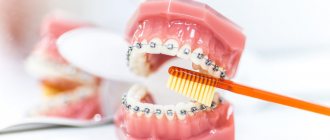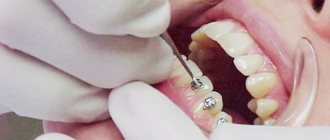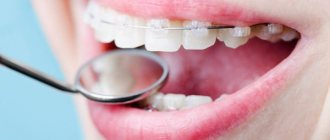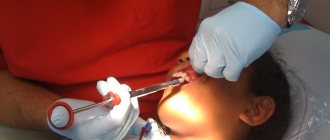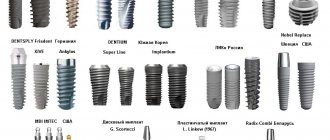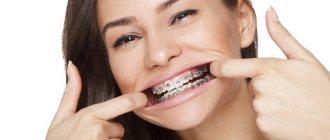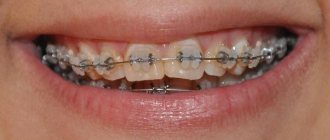3329
For many, braces are the only real way to get a beautiful smile and healthy teeth. Wearing this orthodontic device is long and quite unpleasant.
Let us remind you that children usually get braces no earlier than 12-14 years old, when all their baby teeth have been replaced. Many people are reluctant to agree to treatment because of the possible pain. Let's try to figure out why painful sensations may occur and is it worth fearing ?
Installation
Not only children or teenagers, but sometimes even adults are afraid of pain during installation. To dispel all doubts, you need to know that the process of installing the system - bonding - consists of gluing locks to the enamel. To do this, a special dental adhesive solution is used, to which the base is attached. Obviously, such fixation is absolutely painless.
Children of primary school age and teenagers 12-13 years old are most afraid of bonding, since it is at this age that correction most often begins. The doctor must explain to the patient what will happen and how. If this does not help much, to reduce fear, on the eve of installation you can find a video on the Internet that demonstrates the process.
With direct bonding, the locks are glued to each tooth in turn, and with the indirect method, they are first placed at the desired points on the cast of the jaws, and then at one moment they are all placed together on the dental arch with glue, where they are attached. After this, an arc of the required section is threaded into the grooves.
Direct method of fixing braces
The installation does not foretell pain as such, but there may be several unpleasant moments:
- Preparatory procedures . Before fixation, procedures such as grinding the tooth surface, rinsing and further drying must be carried out. They provide secure attachment. All these stages are carried out carefully and scrupulously, they require enough time. Drying just one tooth takes about two minutes. To prevent the mouth from closing, it is limited with special clamps. This position is unnatural, so it is uncomfortable to be in it. During grinding and drying it can be unpleasant, especially for those people who have increased enamel sensitivity.
- Inserting an arc . This procedure is carried out with a certain pressure on the jaw, otherwise the arch will not fit into the groove. The pressure can be stressful. But experienced orthodontists always warn a person before they start inserting an arch so that it does not come as a surprise.
- End of bonding . Once completed, the mouth retainer is removed and the jaws can be closed. Since the muscles and temporomandibular joints are stiff at this point, the first minutes can be unpleasant. This feeling is no different from that which is present after tooth filling.
It is quite possible to go through all stages of installation without pain. It is important to know that if pain is felt during the process, you should immediately inform the doctor, although most often this feeling is purely psychological in nature in people who are terrified of dentists. In fact, during bonding, the nerve endings are not affected and the teeth are not displaced, so it should not hurt.
Is it painful to put, wear and remove braces on teeth?
During orthodontic treatment, unusual stress and pressure are placed on the teeth. Any medical intervention that is accompanied by the installation of various structures disrupts the natural course of processes. Therefore, slight painful sensations at different stages of correction are a completely natural and easily explained phenomenon.
Each person has an individual pain threshold. What may seem like unbearable pain to one person may be described by another as an unpleasant sensation. It is difficult to objectively say whether it is painful to put on braces, wear them and remove them, since much depends on the individual characteristics of the person.
If you're worried about whether or not braces hurt, don't worry too much about it. There are no reasons for toothache at this stage, since the position of the teeth does not change yet and the nerves are not affected. If someone tells you how painful it is, you shouldn’t take such words for granted.
How is braces installed? After preparing and sanitizing the oral cavity at the dentist, the orthodontist gets to work. He glues braces to each tooth and connects them with a metal arch. It's unpleasant, but not painful.
What can become a source of discomfort at this stage? Initially, the oral cavity is sanitized. If there is a need to remove tartar or change fillings, this may be the first source of pain. When installing braces, the muscles and jaw joints may ache, since this procedure often lasts quite a long time - about one and a half to two hours.
From the moment your braces are installed, you will have to reconsider your habits and diet, and adapt to new sensations. Discomfort at first is inevitable.
We suggest you read: Taste of onion in the mouth causes of the disease
Some people experience pain when wearing braces due to pressure on the teeth, rubbing and damage to the oral mucous membranes by the structural elements. But she goes away pretty quickly.
The pain that occurs after installing braces is easy to deal with if you understand what causes it.
- The first days after you have braces installed, pain is a completely natural phenomenon. The structure puts pressure on the teeth, they begin to actively move in a given direction. After eating, the pain may become a little stronger. Let us remind you that these are completely natural sensations.
- If you find yourself in the hands of an experienced orthodontist, he will accurately calculate the degree of pressure of the structure on the teeth. Therefore, do not panic - in just a couple of weeks the pain will go away. There will only be some discomfort from the sensation of the presence of a foreign structure in the mouth. But if your teeth hurt so much that it’s difficult for you to endure it, then be sure to see a specialist and tell him about it.
- In terms of bite correction, it is stipulated that the arch will need to be changed periodically. Once your new archwire is fitted, the pressure will increase and the pain may return for a while. But it will be much weaker than at the very beginning of treatment.
After removing your braces, a completely different person will look at you in the mirror with an open and beautiful smile.
To the question of whether it hurts to remove braces, you can confidently give a negative answer. At this stage, all unpleasant sensations are already behind us.
Despite the fact that braces are fixed to the teeth very firmly, removing them does not take much time and does not cause discomfort. No matter how many times you wear them, the day your treatment ends is always a joyful event. Now you can look in the mirror and realize that all your efforts were not in vain.
In rare cases, some patients complain of increased headaches after having braces installed. Are they related to orthodontic treatment? Headaches from braces cannot occur without cause.
They can be associated with restructuring and tension in the jaw joints, muscles, and bones. In order for headaches to begin to appear frequently after the installation of an orthodontic structure, another reason is needed.
The only thing braces can do is exacerbate existing problems.
What to do if you have a headache? First of all, see your orthodontist to make sure that the treatment is progressing as needed. But to eliminate problems of this nature, as a rule, a consultation with a neurologist is required, who will help you get rid of discomfort.
As we found out, teeth hurt from braces only for the first time after installing them or replacing the arch. But many are unable to endure even mild pain. If you are planning to install braces, you may find the following tips useful.
- Sometimes pain is caused by damage to the mucous membranes of the mouth due to protruding elements of braces. In this case, doctors recommend using special orthodontic wax. It is enough to take a small piece of wax and stick it on the problem area of the structure.
- If you are unable to bear the pain, then as a last resort you can take a tablet of any over-the-counter pain reliever. But you should not abuse such means and it is better to coordinate this with the orthodontist.
- Some people with braces benefit from salt water rinses. For a glass of water you need to take a teaspoon of salt. This is a traditional medicine recipe, but it really works.
Now you understand that orthodontic treatment is not as scary and painful as it may seem at first or as some impressionable patients describe it.
If you can't decide to get braces, just imagine what your smile will look like after they are removed.
And in conclusion, we invite you to watch an interesting video in which the dentist will talk about whether it really hurts to put on braces.
This is a completely normal question, because many people do not like to visit dental clinics, and they are afraid of dentists like fire. In this article you will learn what sensations accompany the installation and removal of systems, as well as their operation.
Installation phase
This stage of the entire rather lengthy process of installing braces takes quite a lot of time.
In this case, the orthodontist, using a special substance, attaches a small rectangular device, after which the teeth are fastened with a metal structure in the form of an arc.
It has some pressure that will guide the teeth into a certain position to correct the defect.
Bracket system
note
In general, if we answer the question that interests many people, whether it hurts to put on braces, then we can say that this is an absolutely painless procedure. Unless your jaw starts to ache due to being in the dental chair for quite a long time with your mouth open.
Installing structures is a rather difficult decision. However, you should not be afraid of the pain of this procedure. All these fears are completely unfounded.
Operation of systems
After the installation stage, the questions usually do not end. Many patients ask if braces hurt, and this is completely normal. After all, the operational period of the systems is quite long and can even take a couple of years. Prepare yourself for the fact that after your visit to the orthodontist you will feel discomfort for several days.
This is due to the fact that you have a foreign body in your mouth that causes discomfort. Moreover, if you install lingual systems, your tongue will also hurt. Everything is individual and some patients, for example, complain of aching and not particularly severe pain in the jaw. These sensations are caused by pressure on the teeth.
Naturally, it all depends on how sensitive a person is. So, some patients have no pain at all, while others experience very severe discomfort.
Braces lead to aching and not particularly severe pain in the jaw
When a person waits until the winning stage, at which the braces are already removed, he is no longer concerned about the pain of the procedure. The patient is already quite experienced and understands that there is no need to be afraid of a banal intervention.
During all this time, the fear of visiting a medical institution passes, and patients are very happy that they will soon get rid of wires in their teeth. They look forward to finally being able to smile a wide and beautiful smile with perfectly straight teeth.
We suggest you familiarize yourself with: Can a high temperature rise to 37-38 and what can be caused by and with toothache? An adult has a toothache, what to do?
Of course, there are also particularly impressionable people who are incredibly worried before manipulation.
During the operation of systems to correct bite and other defects, you need to visit the dentist from time to time to fix them. The procedure involves gradual pulling into the correct position. This can be achieved through the same wire-shaped structure, which is periodically replaced with another, tighter one.
Pain occurs from time to time when using braces. This is due to the fact that the metal arch puts pressure on the teeth. But particular discomfort is felt in the first days after installation.
Below are recommendations for pain relief:
- If the pain is severe enough, you can take an analgesic. Follow the instructions for their use strictly to avoid overdose. It is also worth paying attention to the conditions for taking these medications. Such medications should not be taken on an empty stomach; The procedure for wearing braces involves gradually pulling the teeth into the correct position
- if there is irritation, you need to use a special wax. This substance is glued to the part of the braces that irritates the mucous membranes. The need to use wax disappears after a while, as a person gets used to the products;
- rinse your mouth to relieve soreness. The rinse liquid should be warm and salted;
- If wounds occur on the mucous membranes, you need to use special healing and disinfecting preparations. These drugs are produced by pharmaceutical organizations. They are sold in pharmacies without a prescription. Ask your doctor to prescribe this medication for you.
Adaptation period
Adaptation of the dental system to braces is the most likely time when a patient may experience pain. The first discomfort is felt within 2-3 hours after installation.
Typically, the following two factors become sources of discomfort:
- Compression on the periodontal ligaments . They are located in the alveolar process of the jaw, so the beginning of their displacement is associated with aching and aching in the jaw bone. Pressure in the periodontal ligaments can cause acute inflammation, which worsens the pain. The most unpleasant sensation occurs at the moment of maximum load on the jaw - while chewing food. In the first days this is considered normal.
- Friction against mucous membranes . Locks, arches, hooks and other structural elements can put pressure on soft tissues. The inner surfaces of the lips and cheeks are usually the most affected. Rubbing, irritation and even small ulcers may appear.
Ulcers on the mucous membrane from wearing braces
At the first stage of wearing braces, the doctor selects an arch of a small cross-section.
If all calculations are performed correctly, then the adaptation process will take place with the least discomfort. The most unpleasant sensations are observed during the first seven days, and by the end of the second or third week they should pass.
Removal
Patients are often worried about the upcoming removal of braces. Since the locks are attached so securely, it seems like they might be painful to unfasten. But during the removal process, no nerve endings are involved, the dentist does not touch the gums, so unpleasant sensations are excluded.
Usually the process of removing braces goes smoothly; neither children nor teenagers are afraid of it, since during the course of correction they have time to get used to visiting a dental office and communicating with their doctor. The most impressionable people may be bothered by the sound of the machine used to remove glue from teeth, as it resembles the sound of drilling dentin. But there is no painful sensation.
What sensations may you feel while wearing braces?
The essence of the process of correcting occlusion anomalies is that, under the pressure of a power arc, the teeth begin to move in a given direction. In this case, the bone tissue of the jaw begins to dissolve on one side and grows on the other. This process is accompanied by the response of nerve endings, the signal from which is sent to the brain. As a result, the person feels a pain reaction. We can conclude that pain during treatment is natural. Therefore, you should not be afraid of her. Over time, the body adapts: the pain will either stop altogether or will be felt as a slight discomfort.
Dependence of pain on the type of system
Even before starting treatment, some patients wonder which type of system causes more pain during bite correction, and which causes less. Studies have been conducted on this topic, and the results showed that a longer pain reaction during the adaptation period was observed in patients with classic braces. Self-ligating systems caused less reaction, and addiction occurred several days faster.
At the same time, it should be noted that the difference in pain was small, but varied depending on the actions performed. With conventional braces, the pain was aching and constant, and in the case of self-ligating structures it intensified when biting or chewing solid food.
Ways to reduce discomfort
You can tolerate minor discomfort, but if the pain becomes severe and interferes with eating or sleeping normally, then you should not suffer. Immediately after installing braces, your doctor may recommend several methods that can reduce discomfort:
- Orthodontic wax . An indispensable tool in the first stages of adaptation. It can be purchased in pharmacies or purchased online. The composition should be applied to locks or arches, other protruding parts that rub the mucous membranes. Some experts advise applying it immediately, without waiting for irritation to appear. It is not necessary to remove the wax before eating, since it does not dissolve in the body, therefore it is excreted in its original form without causing harm to health.
- A solution of water and salt . To reduce inflammation in the gum tissue, a weak saline solution is ideal, which should be warm, but not hot. You can put it in your mouth and rinse your mouth with it for a minute or two.
- Disinfectants . In case of wounds and severe abrasions, the dentist will recommend special pharmaceuticals, the use of which will allow the lesions to heal quickly and prevent bacteria from joining.
- Chamomile or calendula decoction . Rinsing with these solutions helps relieve inflammation and disinfect the mucous membrane, and also increases regenerative abilities.
- Painkillers . If the pain becomes intense, over-the-counter medications can be used. During adaptation to braces, 70% of patients resort to this measure. Most of them no longer need to use painkillers by the third day.
When the pain syndrome becomes too severe, affecting not only the jaw, but also the head and neck, you need to consult your doctor.
What to do to reduce pain with braces
Orthodontists give several recommendations that will facilitate adaptation to the system:
- Eat right. Food should be soft so that there is no excessive stress on the teeth. In the first days, eat yogurts, cereals and purees. Complete the menu with ice cream, as the cold helps relieve gum pain. Avoid foods that contain acid: fruits, berries and pickles, so as not to increase the sensitivity of the enamel.
- Ask your doctor to prescribe pain medications.
- Rinse your mouth with a decoction of chamomile diluted in water with salt or peroxide. Solutions will help relieve swelling of the mucous membrane.
- Massage your gums with your fingers.
- Avoid smoking. Nicotine tars irritate soft tissues.
If the doctor installed the system correctly, the patient’s well-being should improve every day. Pain and swelling will begin to subside, and the mucous membranes will stop reacting to foreign elements.
